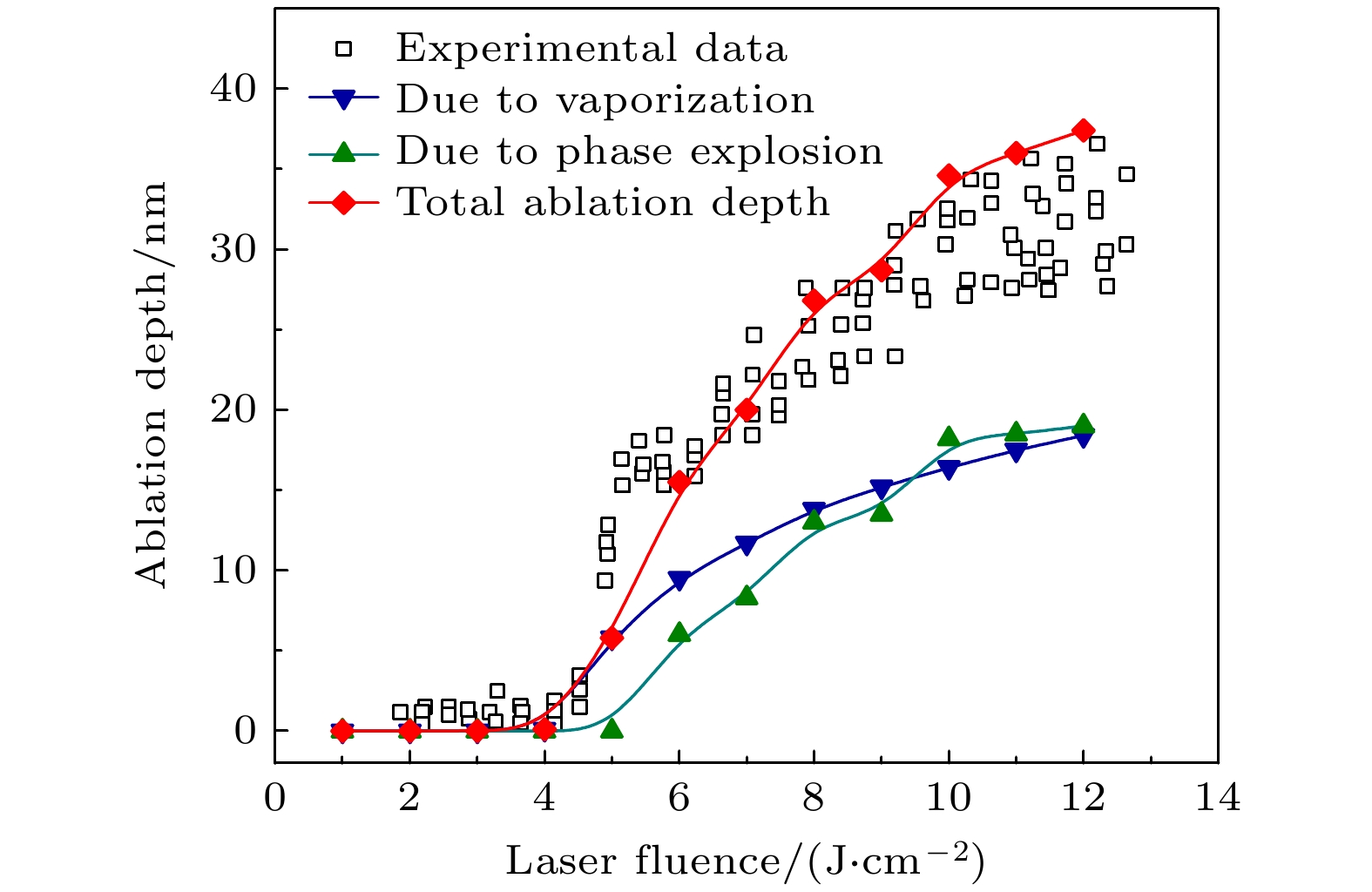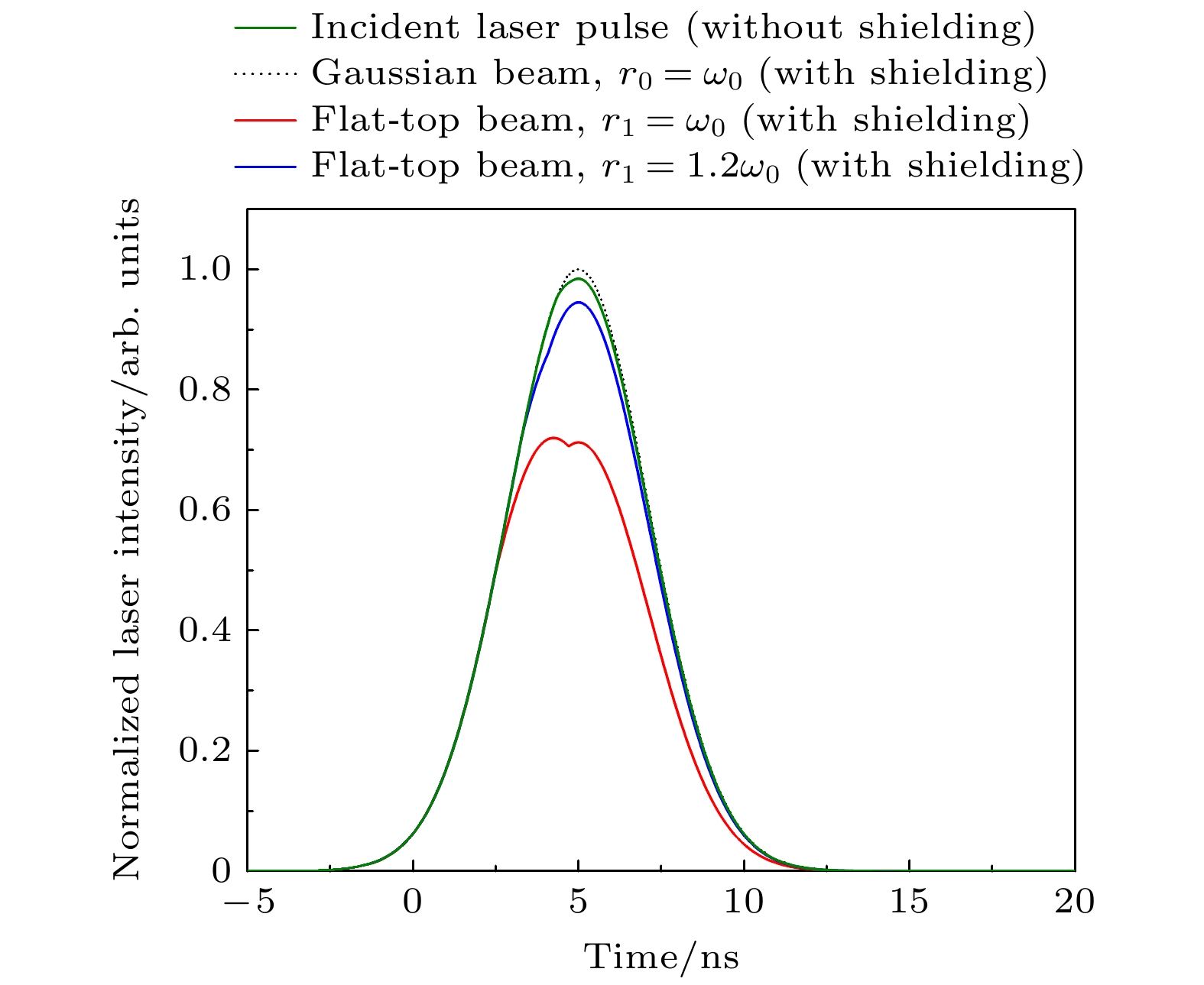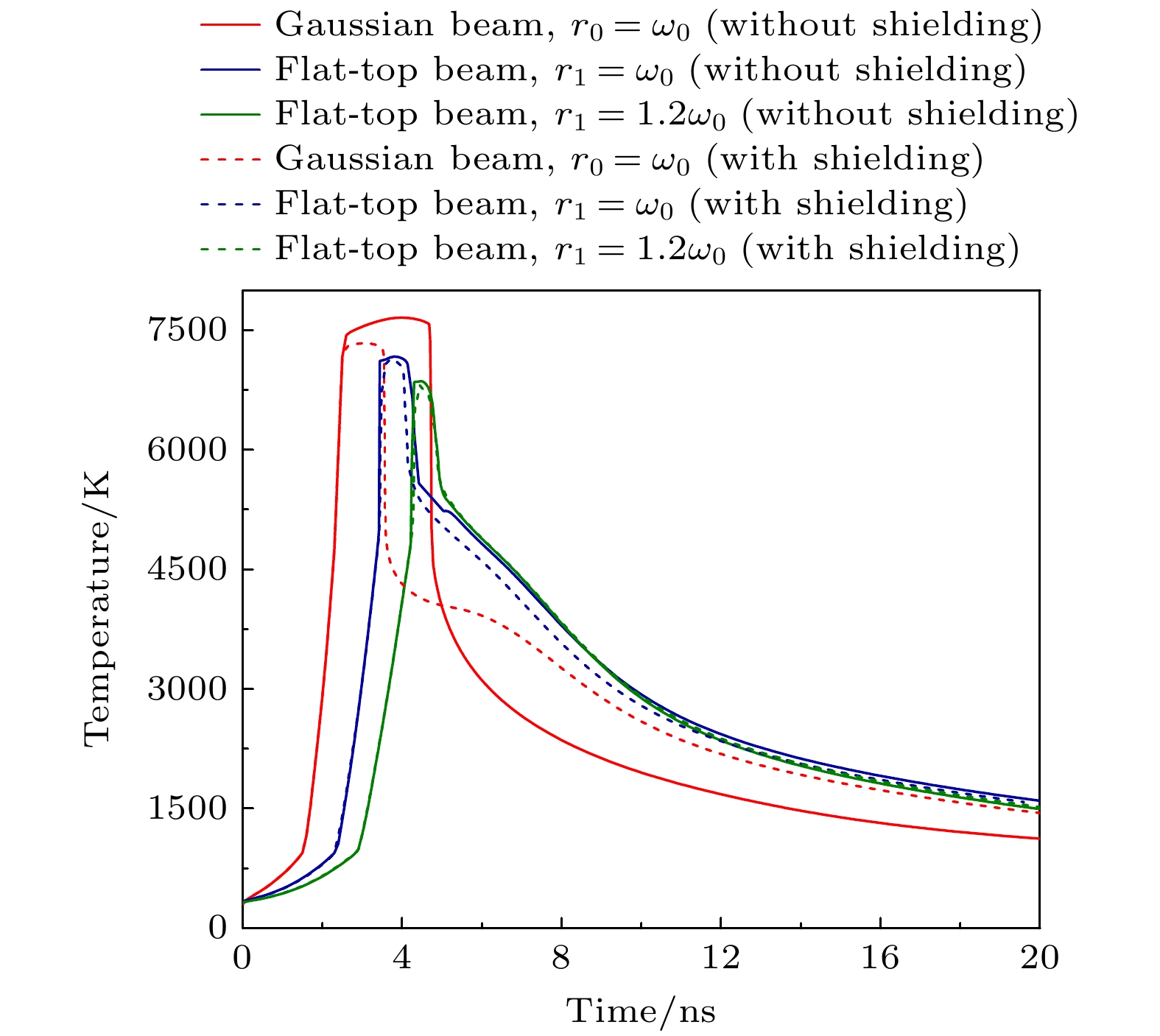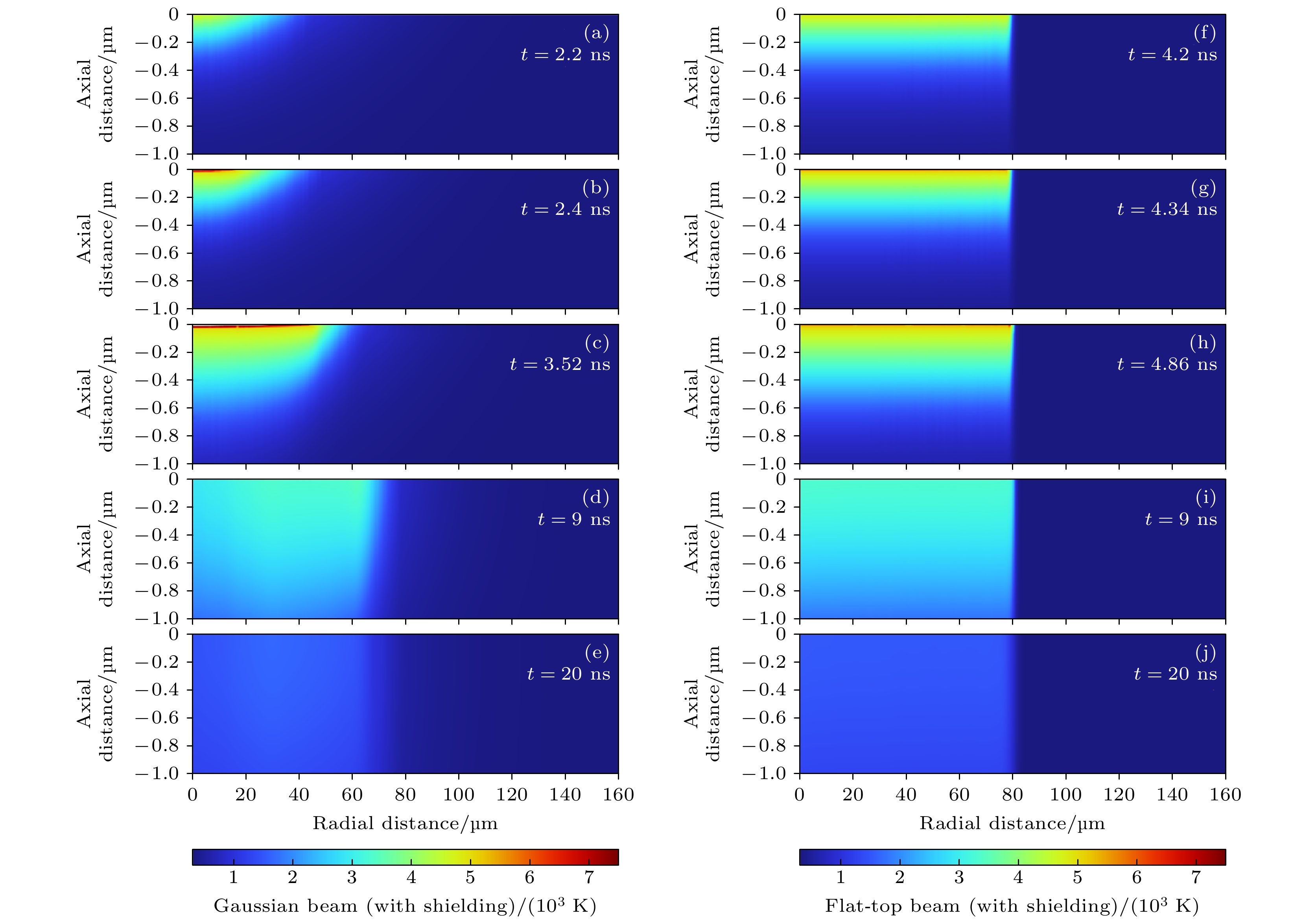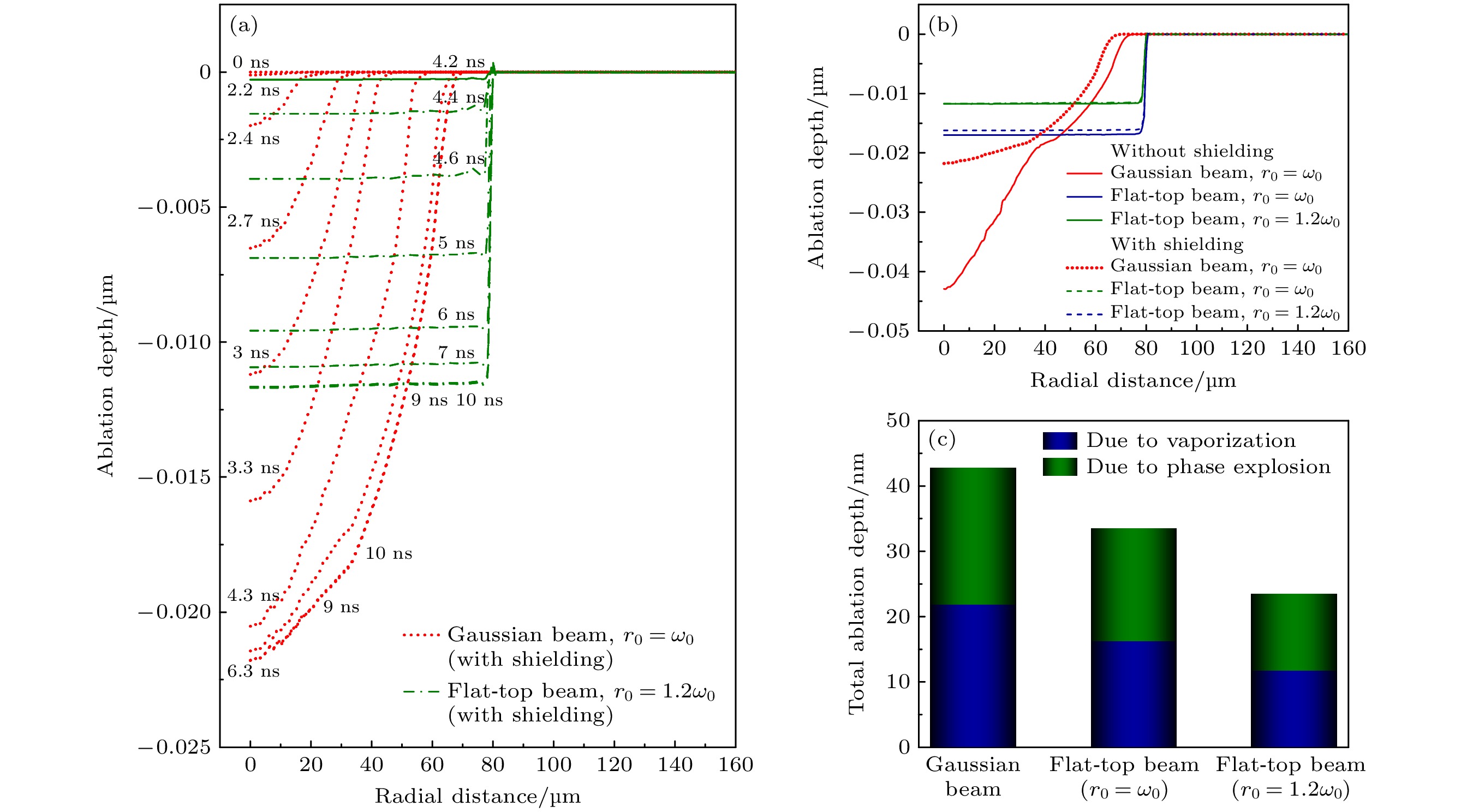-
基于建立的纳秒脉冲激光与金属铝相互作用的二维轴对称模型, 仿真研究了光束整形对纳秒脉冲激光烧蚀金属铝过程中蒸发烧蚀动力学的影响. 结果表明: 等离子体屏蔽对靶材的烧蚀特性具有显著影响, 屏蔽效应主要体现在脉冲的中后期. 对于3种激光轮廓, 高斯光束的屏蔽效果最强, 随着整形后的平顶光束直径的增大, 屏蔽效果逐渐减弱. 平顶光束与高斯光束作用下, 靶材温度的二维空间分布较为不同. 高斯光束作用时, 靶材中心最先升温, 随后温度沿径向和轴向扩散. 由于平顶光束的能量分布更加均匀, 因此一定径向范围内的靶材同时升温. 光束整形对靶材的蒸发烧蚀动力学影响较大. 对于高斯光束, 靶材中心先烧蚀, 随后产生径向烧蚀. 由于整形后平顶光束的能量密度降低, 因此靶面蒸发时间较高斯光束延后, 并且一定径向范围内的靶材同时发生蒸发烧蚀. 3种激光轮廓下, 靶材的蒸发烧蚀形貌与光束的强度分布类似, 其中高斯光束的烧蚀坑呈中间深两边浅的特点, 平顶光束的烧蚀坑较为平坦.Based on the established two-dimensional asymmetric model of the interaction between a nanosecond pulse laser and metallic aluminum, the effect of beam shaping on the evaporation ablation dynamics during the ablation of metallic aluminum by a nanosecond pulse laser is simulated. The results show that plasma shielding, which has a significant influence on the ablation properties of the target, occurs mainly in the middle phase and late phase of the pulse. Among the three laser profiles, the Gaussian beam has the strongest shielding effect. As the diameter of the reshaped flat-top beam increases, the shielding effect gradually weakens. The two-dimensional spatial distribution of target temperature is relatively different between ablation by a Gaussian beam and that by a flat-top beam. For the Gaussian beam, the center of the target is first heated, and then the temperature spreads in radial direction and axial direction. For the flat-top beam, due to the uniform energy distribution, the target is heated within a certain radial range simultaneously. Beam shaping has a great influence on the evaporation ablation dynamics of the target. For the Gaussian beam, the center of the target is first ablated, followed by the radial ablation. For the flat-top beam, the evaporation time of the target surface is delayed due to the lower energy density after the beam has been shaped. In addition, the target evaporates simultaneously in a certain radial range due to the more uniform distribution of laser energy. For each of the three laser profiles, the evaporation morphology of the target resembles the intensity distribution of the laser beam. The crater produced by the Gaussian beam is deep in the center and shallow on both sides, while it becomes relatively flat by the flat-top beam.
[1] Schaffer C B, Brodeur A, Mazur E 2001 Meas. Sci. Technol. 12 1784
 Google Scholar
Google Scholar
[2] Hahn D W, Omenetto N 2012 Appl. Spectrosc. 66 347
 Google Scholar
Google Scholar
[3] Baudelet M, Yu J, Bossu M, Jovelet J, Wolf J P, Amodeo T, Fréjafon E, Laloi P 2006 Appl. Phys. Lett. 89 163903
 Google Scholar
Google Scholar
[4] 董鹏凯, 赵上勇, 郑柯鑫, 王冀, 高勋, 郝作强, 林景全 2021 物理学报 70 040201
 Google Scholar
Google Scholar
Dong K P, Zhao S Y, Zheng K X, Wang J, Gao X, Hao Z Q, Lin J Q 2021 Acta Phys. Sin. 70 040201
 Google Scholar
Google Scholar
[5] 黄梅婷, 姜银花, 陈钰琦, 李润华 2021 物理学报 70 104206
 Google Scholar
Google Scholar
Huang M T, Jiang Y H, Chen Y Q, Li R H 2021 Acta Phys. Sin. 70 104206
 Google Scholar
Google Scholar
[6] Lithgow G A, Robinson A L, Buckley S G 2004 Atmos. Environ. 38 3319
 Google Scholar
Google Scholar
[7] Burgio L, Melessanaki K, Doulgeridis M, Clark R J H, Anglos D 2001 Spectrochim. Acta Part B 56 905
 Google Scholar
Google Scholar
[8] Tiwari M, Agrawal R, Pathak A K, Rai A K, Rai G K 2013 Spectrosc. Lett. 46 155
 Google Scholar
Google Scholar
[9] 张大成, 马新文, 朱小龙, 李斌, 祖凯玲 2008 物理学报 57 6348
 Google Scholar
Google Scholar
Zhang D C, Ma X W, Zhu X L, Li B, Zu K L 2008 Acta Phys. Sin. 57 6348
 Google Scholar
Google Scholar
[10] Rai N K, Rai A K 2008 J. Hazard. Mater. 150 835
 Google Scholar
Google Scholar
[11] Jia J W, Fu H B, Hou Z Y, Wang H D, Ni Z B, Wang Z, Dong F Z, Zhang Z R 2019 J. Phys. D: Appl. Phys. 52 405102
 Google Scholar
Google Scholar
[12] Jia J W, Fu H B, Hou Z Y, Wang H D, Wang Z, Dong F Z, Ni Z B, Zhang Z R 2020 Spectrochim. Acta Part B 163 105747
 Google Scholar
Google Scholar
[13] Hou Z Y, Afgan M S, Sheta S, Wang Z 2020 J. Anal. At. Spectrom. 35 1671
 Google Scholar
Google Scholar
[14] Ji J X, Song W R, Hou Z Y, Li L, Yu X, W Z 2022 Anal. Chim. Acta 1235 340551
 Google Scholar
Google Scholar
[15] Knight C J 1979 AIAA J. 17 519
 Google Scholar
Google Scholar
[16] Mazhukin V I, Nossov V V, Smurov I 2004 Thin Solid Films 453 353
 Google Scholar
Google Scholar
[17] Stafe M, Negutu C, Popescu I M 2007 Appl. Surf. Sci. 253 6353
 Google Scholar
Google Scholar
[18] Lu Q, Mao S S, Mao X, Russo R E 2008 J. Appl. Phys. 104 1695
 Google Scholar
Google Scholar
[19] Zhang W, Yao Y L, Chen K 2001 Int. J. Adv. Manuf. Technol. 18 323
 Google Scholar
Google Scholar
[20] Kelly R, Miotello A 1996 Appl. Surf. Sci. 96 205
 Google Scholar
Google Scholar
[21] Porneala C, Willis D A 2006 Int. J. Heat Mass Transfer 49 1928
 Google Scholar
Google Scholar
[22] Pierron N, Sallamand P, Matteï S 2007 Appl. Surf. Sci. 253 3208
 Google Scholar
Google Scholar
[23] Korobenko V N, Rakhel A D, Savvatimski A I, Fortov, V. E 2005 Phys. Rev. B 71 014208
 Google Scholar
Google Scholar
[24] Wu B, Shin Y C 2006 Appl. Phys. Lett. 89 111902
 Google Scholar
Google Scholar
[25] Gragossian A, Tavassoli S H, Shokri B 2009 J. Appl. Phys. 105 103304
 Google Scholar
Google Scholar
[26] Lutey, Adrian A H 2013 J. Manuf. Sci. Eng. 135 061003
 Google Scholar
Google Scholar
[27] Marla D, Bhandarkar U V, Joshi S S 2014 Appl. Phys. A 116 273
 Google Scholar
Google Scholar
[28] Stafe M 2012 J. Appl. Phys. 112 123112
 Google Scholar
Google Scholar
[29] Bogaerts A, Chen Z, Gijbels R, Vertes A 2003 Spectrochim. Acta Part B 58 1867
 Google Scholar
Google Scholar
[30] Nosrati Y, Tavassoli S H, Hassanimatin M M, Safi A 2020 Phys. Plasmas 27 023301
 Google Scholar
Google Scholar
[31] Zhang Y, Zhang D X, Wu J J, He Z, Deng X 2017 AIP Adv. 7 075010
 Google Scholar
Google Scholar
[32] Ghalamdaran S, Parvin P, Javad Torkamany M, Sabbagh Zadeh J 2014 J. Laser Appl. 26 012009
 Google Scholar
Google Scholar
[33] Wang Y, Hahn D W 2019 Appl. Phys. A 125 1
 Google Scholar
Google Scholar
[34] Sinha S 2010 J. Nucl. Mater. 396 257
 Google Scholar
Google Scholar
[35] Yu J, Ma Q L, Motto-Ros V, Lei W Q, Wang X C, Bai X S 2012 Front. Phys. 7 649
 Google Scholar
Google Scholar
[36] Kumar K K, Samuel G L, Shunmugam M S 2019 J. Mater. Process. Technol. 263 266
 Google Scholar
Google Scholar
[37] Zhang C, Zhou J, Shen H 2017 J Manuf Sci Eng. 139 041019
 Google Scholar
Google Scholar
[38] Bulgakova N M, Bulgakov A V 2001 Appl. Phys. A 73 199
 Google Scholar
Google Scholar
[39] Sakai T 2009 J. Propul. Power 25 406
 Google Scholar
Google Scholar
[40] Lee J, Yoo J, Lee K 2014 J. Mech. Sci. Technol. 28 1797
 Google Scholar
Google Scholar
[41] Terragni J, Miotello A 2021 Micromachines 12 300
 Google Scholar
Google Scholar
[42] Brandt R, Neuer G 2007 Int. J. Thermophys. 28 1429
 Google Scholar
Google Scholar
[43] Morel V, Bultel A, Chéron B G 2009 Int. J. Thermophys. 30 1853
 Google Scholar
Google Scholar
[44] Shen Z H, Zhang S Y, Lu J, Ni X W 2001 Opt. Laser Technol. 33 533
 Google Scholar
Google Scholar
[45] Porneala C, Willis D A 2006 Appl. Phys. Lett. 89 21
 Google Scholar
Google Scholar
-
图 5 F = 20 J/cm2, 考虑等离子体屏蔽时, 不同时刻的靶材温度分布 (a)—(e)高斯光束烧蚀结果; (f)—(j)平顶光束$ \left( {{r_1} = 1.2{\omega _0}} \right) $烧蚀结果; 其中, (a), (f)代表靶材蒸发开始时刻; (b), (g)代表高温开始时刻; (c), (h)代表高温结束时刻; (d), (i)代表靶材蒸发结束时刻; (e), (j)代表靶材仿真结束时刻
Fig. 5. Temperature distribution of the target for laser fluence of 20 J/cm2 with considering the plasma shielding: (a)–(e) Gaussian beam ablation results; (f)–(j) flat-top beam ablation results; where among them, (a), (f) the initial time of evaporation; (b), (g) the initial time of high temperature; (c), (h) the end time of high temperature; (d), (i) the end time of evaporation; (e), (j) the end time of simulation.
图 7 F = 20 J/cm2, 靶材蒸发烧蚀坑形貌和总烧蚀深度 (a)实时蒸发形貌; (b)最终蒸发形貌; (c)总烧蚀深度
Fig. 7. Target ablation crater morphology due to vaporization and total ablation depth for laser fluence of 20 J/cm2: (a) The real-time morphology due to vaporization; (b) the final morphology due to vaporization; (c) total ablation depth.
参数 数值 单位 密度
($\rho $)$ \rho = \left\{ {\begin{aligned} &{2700, }&&{T \leqslant {T_{\text{m}}}} \\ & {{\rho _{\text{c}}}\left[ {1 + 0.75\left( {1 - {T / {{T_{\text{c}}}}}} \right) + 3{{\left( {1 - {T / {{T_{\text{c}}}}}} \right)}^{{1/3}}}} \right], }&&{{T_{\text{m}}} < T \leqslant {0}{.8}{T_{\text{c}}}} \\ &{634, }&&{T > {0}{.8}{T_{\text{c}}}} \end{aligned}} \right. $ $ {{{\text{kg}}} \mathord{\left/ {\vphantom {{{\text{kg}}} {{{\text{m}}^{3}}}}} \right. } {{{\text{m}}^{3}}}} $ 电导率
($\sigma $)$ \sigma \left( T \right) = \left\{ {\begin{aligned} &{3.69 \times {{10}^7}, }&&{T \leqslant {T_{\text{m}}}} \\ & {{{{{10}^8}} / {\left( {0.00852 T + 15.32896} \right), }}}&&{{T_{\text{m}}} < T \leqslant {0}{.8}{T_{\text{c}}}} \qquad\qquad \quad \\ &{2.52 \times {{10}^4}, }&&{T > {0}{.8}{T_{\text{c}}}} \end{aligned}} \right. $ $ {{\text{S}} \mathord{\left/ {\vphantom {{\text{S}} {\text{m}}}} \right. } {\text{m}}} $ 热导率
($k$)$ k\left( T \right) = \left\{ {\begin{aligned}& {237, }&&{T \leqslant {T_{\text{m}}}} \\ &{2.44 \times {{10}^{ - 8}}\sigma \left( T \right)T, }&&{T > {T_{\text{m}}}} \qquad\qquad \end{aligned}} \right. $ $ \rm W/(m{\cdot}K)$ 反射率
($R$)$ R = \left\{ {\begin{aligned} &{95{\text{%}} , }&&{T \leqslant {T_{\text{m}}}} \\ &{\frac{{{{\left[ {{n_{\text{R}}}\left( T \right) - 1} \right]}^2} + n_{\text{I}}^{2}\left( T \right)}}{{{{\left[ {{n_{\text{R}}}\left( T \right) + 1} \right]}^2} + n_{\text{I}}^{2}\left( T \right)}}, }&&{{T_{\text{m}}} < T \leqslant {0}{.8}{T_{\text{c}}}} \\ &{{\text{69{\text{%}} , }}}&&{T > {0}{.8}{T_{\text{c}}}} \end{aligned}} \right. $ $1$ 吸收系数
($\alpha $)$ \alpha = \left\{ {\begin{aligned} &{1.5 \times {{10}^8}, }&&{T < {T_{\text{m}}}} \\ & {{{4{\text{π }}} }{n_{\text{I}}}\left( T \right)/{\lambda }, }&&{{T_{\text{m}}} \leqslant T \leqslant {0}{.8}{T_{\text{c}}}} \qquad\qquad\quad\\ & {8.5 \times {{10}^6}, }&&{T > {0}{.8}{T_{\text{c}}}} \end{aligned}} \right. $ ${{\text{m}}^{{{ - 1}}}}$ 注: ${n_{\text{R}}}$和${n_{\text{I}}}$分别代表折射率的实部和虚部. 参数 符号 数值 单位 固相线温度 ${T_{\text{s}}}$ 936.15 K 液相线温度 ${T_{\text{l}}}$ 939.15 K 熔点 ${T_{\text{m}}}$ 933 K 沸点 ${T_{\text{v}}}$ 2793 K 临界温度 ${T_{\text{c}}}$ 6700 K 临界密度 ${\rho _{\text{c}}}$ 634 ${{{\text{kg}}} / {{{\text{m}}^{3}}}}$ 固相恒压热容 ${C_{{\text{ps}}}}$ 917 $ {{\text{J}} / ( {{\text{kg}} \cdot {\text{K}}})} $ 液相恒压热容 ${C_{{\text{pl}}}}$ 1080 $ {{\text{J}} /{\left( {{\text{kg}} \cdot {\text{K}}} \right)}} $ 融化潜热 ${L_{\text{m}}}$ $ 3.69 \times {10^{5}} $ $ {{\text{J}} /{{\text{kg}}}} $ 蒸发潜热 ${L_{\text{v}}}$ $ {1}{.05} \times {10^{7}} $ $ {{\text{J}} /{{\text{kg}}}} $ -
[1] Schaffer C B, Brodeur A, Mazur E 2001 Meas. Sci. Technol. 12 1784
 Google Scholar
Google Scholar
[2] Hahn D W, Omenetto N 2012 Appl. Spectrosc. 66 347
 Google Scholar
Google Scholar
[3] Baudelet M, Yu J, Bossu M, Jovelet J, Wolf J P, Amodeo T, Fréjafon E, Laloi P 2006 Appl. Phys. Lett. 89 163903
 Google Scholar
Google Scholar
[4] 董鹏凯, 赵上勇, 郑柯鑫, 王冀, 高勋, 郝作强, 林景全 2021 物理学报 70 040201
 Google Scholar
Google Scholar
Dong K P, Zhao S Y, Zheng K X, Wang J, Gao X, Hao Z Q, Lin J Q 2021 Acta Phys. Sin. 70 040201
 Google Scholar
Google Scholar
[5] 黄梅婷, 姜银花, 陈钰琦, 李润华 2021 物理学报 70 104206
 Google Scholar
Google Scholar
Huang M T, Jiang Y H, Chen Y Q, Li R H 2021 Acta Phys. Sin. 70 104206
 Google Scholar
Google Scholar
[6] Lithgow G A, Robinson A L, Buckley S G 2004 Atmos. Environ. 38 3319
 Google Scholar
Google Scholar
[7] Burgio L, Melessanaki K, Doulgeridis M, Clark R J H, Anglos D 2001 Spectrochim. Acta Part B 56 905
 Google Scholar
Google Scholar
[8] Tiwari M, Agrawal R, Pathak A K, Rai A K, Rai G K 2013 Spectrosc. Lett. 46 155
 Google Scholar
Google Scholar
[9] 张大成, 马新文, 朱小龙, 李斌, 祖凯玲 2008 物理学报 57 6348
 Google Scholar
Google Scholar
Zhang D C, Ma X W, Zhu X L, Li B, Zu K L 2008 Acta Phys. Sin. 57 6348
 Google Scholar
Google Scholar
[10] Rai N K, Rai A K 2008 J. Hazard. Mater. 150 835
 Google Scholar
Google Scholar
[11] Jia J W, Fu H B, Hou Z Y, Wang H D, Ni Z B, Wang Z, Dong F Z, Zhang Z R 2019 J. Phys. D: Appl. Phys. 52 405102
 Google Scholar
Google Scholar
[12] Jia J W, Fu H B, Hou Z Y, Wang H D, Wang Z, Dong F Z, Ni Z B, Zhang Z R 2020 Spectrochim. Acta Part B 163 105747
 Google Scholar
Google Scholar
[13] Hou Z Y, Afgan M S, Sheta S, Wang Z 2020 J. Anal. At. Spectrom. 35 1671
 Google Scholar
Google Scholar
[14] Ji J X, Song W R, Hou Z Y, Li L, Yu X, W Z 2022 Anal. Chim. Acta 1235 340551
 Google Scholar
Google Scholar
[15] Knight C J 1979 AIAA J. 17 519
 Google Scholar
Google Scholar
[16] Mazhukin V I, Nossov V V, Smurov I 2004 Thin Solid Films 453 353
 Google Scholar
Google Scholar
[17] Stafe M, Negutu C, Popescu I M 2007 Appl. Surf. Sci. 253 6353
 Google Scholar
Google Scholar
[18] Lu Q, Mao S S, Mao X, Russo R E 2008 J. Appl. Phys. 104 1695
 Google Scholar
Google Scholar
[19] Zhang W, Yao Y L, Chen K 2001 Int. J. Adv. Manuf. Technol. 18 323
 Google Scholar
Google Scholar
[20] Kelly R, Miotello A 1996 Appl. Surf. Sci. 96 205
 Google Scholar
Google Scholar
[21] Porneala C, Willis D A 2006 Int. J. Heat Mass Transfer 49 1928
 Google Scholar
Google Scholar
[22] Pierron N, Sallamand P, Matteï S 2007 Appl. Surf. Sci. 253 3208
 Google Scholar
Google Scholar
[23] Korobenko V N, Rakhel A D, Savvatimski A I, Fortov, V. E 2005 Phys. Rev. B 71 014208
 Google Scholar
Google Scholar
[24] Wu B, Shin Y C 2006 Appl. Phys. Lett. 89 111902
 Google Scholar
Google Scholar
[25] Gragossian A, Tavassoli S H, Shokri B 2009 J. Appl. Phys. 105 103304
 Google Scholar
Google Scholar
[26] Lutey, Adrian A H 2013 J. Manuf. Sci. Eng. 135 061003
 Google Scholar
Google Scholar
[27] Marla D, Bhandarkar U V, Joshi S S 2014 Appl. Phys. A 116 273
 Google Scholar
Google Scholar
[28] Stafe M 2012 J. Appl. Phys. 112 123112
 Google Scholar
Google Scholar
[29] Bogaerts A, Chen Z, Gijbels R, Vertes A 2003 Spectrochim. Acta Part B 58 1867
 Google Scholar
Google Scholar
[30] Nosrati Y, Tavassoli S H, Hassanimatin M M, Safi A 2020 Phys. Plasmas 27 023301
 Google Scholar
Google Scholar
[31] Zhang Y, Zhang D X, Wu J J, He Z, Deng X 2017 AIP Adv. 7 075010
 Google Scholar
Google Scholar
[32] Ghalamdaran S, Parvin P, Javad Torkamany M, Sabbagh Zadeh J 2014 J. Laser Appl. 26 012009
 Google Scholar
Google Scholar
[33] Wang Y, Hahn D W 2019 Appl. Phys. A 125 1
 Google Scholar
Google Scholar
[34] Sinha S 2010 J. Nucl. Mater. 396 257
 Google Scholar
Google Scholar
[35] Yu J, Ma Q L, Motto-Ros V, Lei W Q, Wang X C, Bai X S 2012 Front. Phys. 7 649
 Google Scholar
Google Scholar
[36] Kumar K K, Samuel G L, Shunmugam M S 2019 J. Mater. Process. Technol. 263 266
 Google Scholar
Google Scholar
[37] Zhang C, Zhou J, Shen H 2017 J Manuf Sci Eng. 139 041019
 Google Scholar
Google Scholar
[38] Bulgakova N M, Bulgakov A V 2001 Appl. Phys. A 73 199
 Google Scholar
Google Scholar
[39] Sakai T 2009 J. Propul. Power 25 406
 Google Scholar
Google Scholar
[40] Lee J, Yoo J, Lee K 2014 J. Mech. Sci. Technol. 28 1797
 Google Scholar
Google Scholar
[41] Terragni J, Miotello A 2021 Micromachines 12 300
 Google Scholar
Google Scholar
[42] Brandt R, Neuer G 2007 Int. J. Thermophys. 28 1429
 Google Scholar
Google Scholar
[43] Morel V, Bultel A, Chéron B G 2009 Int. J. Thermophys. 30 1853
 Google Scholar
Google Scholar
[44] Shen Z H, Zhang S Y, Lu J, Ni X W 2001 Opt. Laser Technol. 33 533
 Google Scholar
Google Scholar
[45] Porneala C, Willis D A 2006 Appl. Phys. Lett. 89 21
 Google Scholar
Google Scholar
计量
- 文章访问数: 7029
- PDF下载量: 194
- 被引次数: 0















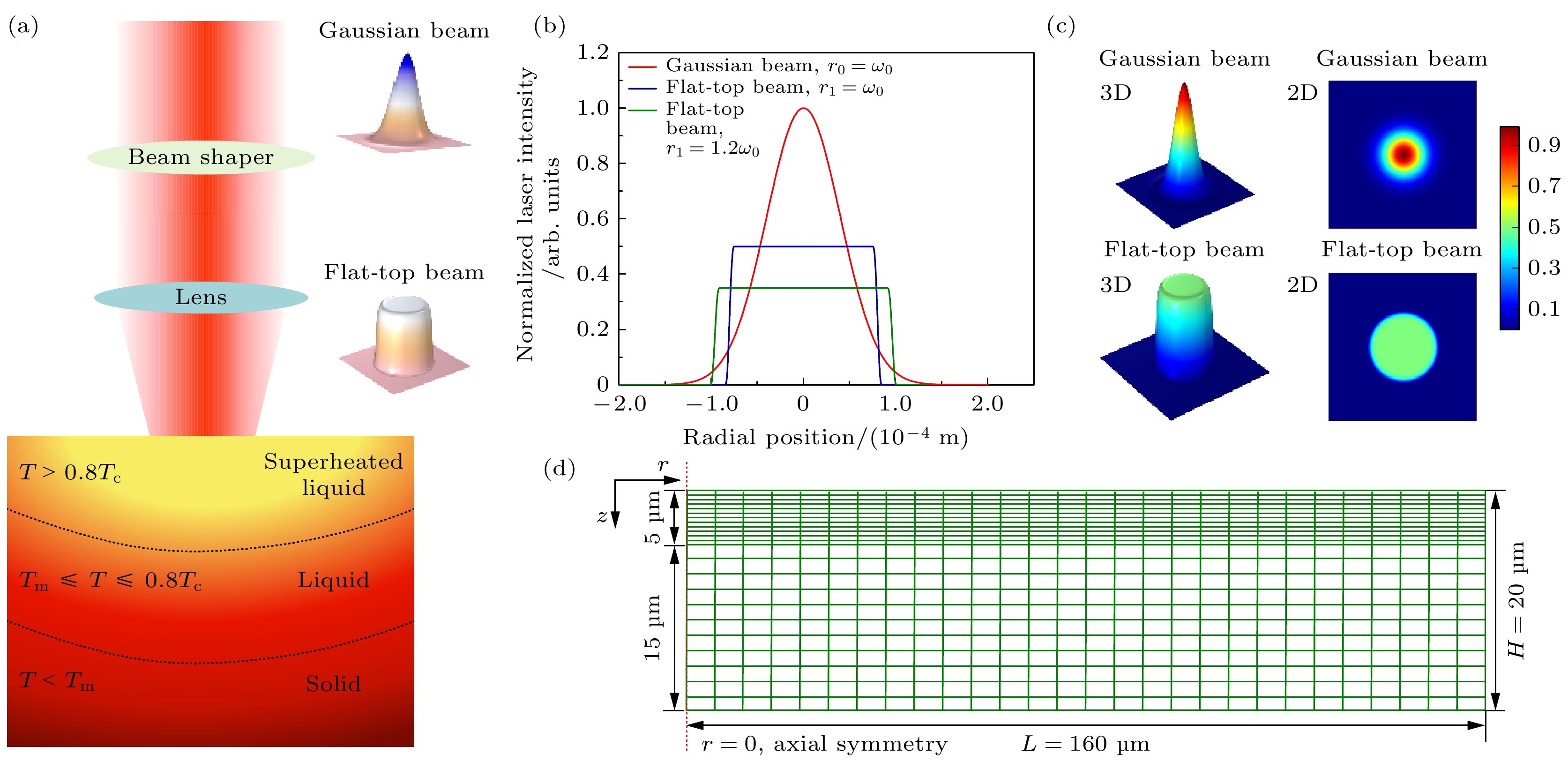
 下载:
下载:
